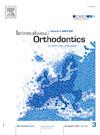三种面部生长模式的下颌管角度、长度和曲率及其与成人患者垂直发育不良指标的关系:一项回顾性横断面头颅测量研究
IF 1.9
Q2 DENTISTRY, ORAL SURGERY & MEDICINE
引用次数: 0
摘要
目的比较不同面部生长模式的下颌管(MC)形态及其与其他常见垂直发育不良指标(VDI)的关系。材料和方法111例(18-40岁)的后处理侧位脑电图根据SNGoGn将其分为正常(ND)、低发散(HypoD)和高发散(HyperD)生长模式。应用头颅测量软件测量下颌管角(MCA)和VDI。采用b样条曲线拟合法计算下颌管长度(MCL)和下颌管曲率(MCC)。统计分析包括比较三种增长模式的MC变量,并评估它们与其他VDI的相关性。采用线性模型评价生长方式、年龄和性别对MC变量的多变量影响。结果HyperD组MCA中位值最高(150°),其次为ND(146°)和HypoD(141°),两组间P <差异均有统计学意义;0.001. 各组间MCL差异无统计学意义(ND = 57±4.3 mm, HypoD = 58.2±4.5 mm, HyperD = 57.9±5.1 mm)。HyperD组MCC半径(44.9±8.7 mm)高于ND组(39.1±11.7,P = 0.034)和HypoD组(38.7±8.5 mm, P = 0.026),表明HyperD组MCC弯曲程度较低。个体的年龄和性别对MC变量没有显著影响。虽然MCA与许多VDI表现出中度到高度的相关性,但其他两个与大多数VDI不相关。结论下颌管角度和弯曲度是潜在的面部生长模式的头侧测量指标,下颌管角度和弯曲度在常规临床应用中更为可靠和实用。本文章由计算机程序翻译,如有差异,请以英文原文为准。
Mandibular canal angle, length and curvature in the three facial growth patterns and their association with vertical dysplasia indicators in adult patients: A retrospective cross-sectional 2D cephalometric study
Objective
The study compared the cephalometric mandibular canal (MC) morphology in different facial growth patterns and its association with other common vertical dysplasia indicators (VDI).
Material and methods
Pretreatment lateral cephalograms of 111 individuals (18–40 years) were categorised as normodivergent (ND), hypodivergent (HypoD), and hyperdivergent (HyperD) growth patterns based on SNGoGn. The mandibular canal angle (MCA) and VDI were estimated using cephalometric software. The mandibular canal length (MCL) and mandibular canal curvature (MCC) were calculated using the B-spline curve fitting method. The statistical analyses included comparing the MC variables across the three growth patterns and assessing their correlations with other VDI. Linear models were used to evaluate the multivariate effects of growth pattern, age and sex on MC variables.
Results
The HyperD group showed the highest median MCA (150°) followed by ND (146°) and HypoD (141°), with all intergroup differences significant at P < 0.001. There was no statistically significant difference in the MCL between the groups (ND = 57 ± 4.3, HypoD = 58.2 ± 4.5, HyperD = 57.9 ± 5.1 mm). The MCC radius was higher in HyperD (44.9 ± 8.7 mm) than in ND (39.1 ± 11.7, P = 0.034) and HypoD group (38.7 ± 8.5 mm, P = 0.026), implying a less curved MC in HyperD group. The age and sex of the individual did not have any significant impact on the MC variables. While MCA demonstrated moderate to high correlation with many VDI, the other two were not correlated with most.
Conclusion
The mandibular canal angle and curvature are potential cephalometric indicators of facial growth patterns, with the former being more robust and practical for routine clinical applications.
求助全文
通过发布文献求助,成功后即可免费获取论文全文。
去求助
来源期刊

International Orthodontics
DENTISTRY, ORAL SURGERY & MEDICINE-
CiteScore
2.50
自引率
13.30%
发文量
71
审稿时长
26 days
期刊介绍:
Une revue de référence dans le domaine de orthodontie et des disciplines frontières Your reference in dentofacial orthopedics International Orthodontics adresse aux orthodontistes, aux dentistes, aux stomatologistes, aux chirurgiens maxillo-faciaux et aux plasticiens de la face, ainsi quà leurs assistant(e)s. International Orthodontics is addressed to orthodontists, dentists, stomatologists, maxillofacial surgeons and facial plastic surgeons, as well as their assistants.
 求助内容:
求助内容: 应助结果提醒方式:
应助结果提醒方式:


